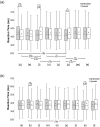Interaction between grasping and articulation: How vowel and consonant pronunciation influences precision and power grip responses
- PMID: 35316305
- PMCID: PMC8939804
- DOI: 10.1371/journal.pone.0265651
Interaction between grasping and articulation: How vowel and consonant pronunciation influences precision and power grip responses
Abstract
Grasping and mouth movements have been proposed to be integrated anatomically, functionally and evolutionarily. In line with this, we have shown that there is a systematic interaction between particular speech units and grip performance. For example, when the task requires pronouncing a speech unit simultaneously with grasp response, the speech units [i] and [t] are associated with relatively rapid and accurate precision grip responses, while [ɑ] and [k] are associated with power grip responses. This study is aimed at complementing the picture about which vowels and consonants are associated with these grasp types. The study validated our view that the high-front vowels and the alveolar consonants are associated with precision grip responses, while low and high-back vowels as well as velar consonants or those whose articulation involves the lowering of the tongue body are associated with power grip responses. This paper also proposes that one reason why small/large concepts are associated with specific speech sounds in the sound-magnitude symbolism is because articulation of these sounds is programmed within the overlapping mechanisms of precision or power grasping.
Conflict of interest statement
The authors have declared that no competing interests exist.
Figures


Similar articles
-
Systematic Influence of Perceived Grasp Shape on Speech Production.PLoS One. 2017 Jan 19;12(1):e0170221. doi: 10.1371/journal.pone.0170221. eCollection 2017. PLoS One. 2017. PMID: 28103278 Free PMC article.
-
The Sound of Grasp Affordances: Influence of Grasp-Related Size of Categorized Objects on Vocalization.Cogn Sci. 2019 Oct;43(10):e12793. doi: 10.1111/cogs.12793. Cogn Sci. 2019. PMID: 31621124
-
Reaching and grasping with the tongue: Shared motor planning between hand actions and articulatory gestures.Q J Exp Psychol (Hove). 2018 Oct;71(10):2129-2141. doi: 10.1177/1747021817738732. Epub 2018 Jan 1. Q J Exp Psychol (Hove). 2018. PMID: 30226427
-
Connection between movements of mouth and hand: Perspectives on development and evolution of speech.Neurosci Biobehav Rev. 2019 May;100:211-223. doi: 10.1016/j.neubiorev.2019.03.005. Epub 2019 Mar 11. Neurosci Biobehav Rev. 2019. PMID: 30871957 Review.
-
Sound-Action Symbolism.Front Psychol. 2021 Sep 14;12:718700. doi: 10.3389/fpsyg.2021.718700. eCollection 2021. Front Psychol. 2021. PMID: 34594278 Free PMC article. Review.
Cited by
-
Neural Basis Of Sound-Symbolic Pseudoword-Shape Correspondences.bioRxiv [Preprint]. 2023 Jun 26:2023.04.14.536865. doi: 10.1101/2023.04.14.536865. bioRxiv. 2023. PMID: 37425853 Free PMC article. Preprint.
-
Neural basis of sound-symbolic pseudoword-shape correspondences.Neuropsychologia. 2023 Sep 9;188:108657. doi: 10.1016/j.neuropsychologia.2023.108657. Epub 2023 Aug 3. Neuropsychologia. 2023. PMID: 37543139 Free PMC article.
-
Beyond grasping: Syllables processing influences mere manual keypress.Psychon Bull Rev. 2023 Dec;30(6):2203-2209. doi: 10.3758/s13423-023-02307-0. Epub 2023 May 25. Psychon Bull Rev. 2023. PMID: 37227672
-
Sound-action symbolism in relation to precision manipulation and whole-hand grasp usage.Q J Exp Psychol (Hove). 2024 Jan;77(1):191-203. doi: 10.1177/17470218231160910. Epub 2023 Mar 21. Q J Exp Psychol (Hove). 2024. PMID: 36847470 Free PMC article.
-
Sound symbolism in manual and vocal responses: phoneme-response interactions associated with grasping as well as vertical and size dimensions of keypresses.Cogn Process. 2024 Aug;25(3):363-378. doi: 10.1007/s10339-024-01188-y. Epub 2024 Apr 12. Cogn Process. 2024. PMID: 38607468 Free PMC article.
References
-
- Desmurget M, Richard N, Harquel S, Baraduc P, Szathmari A, Mottolese C, et al.. Representations of ethologically relevant hand/mouth synergies in the human precentral gyrus. Proceedings of the National Academy of Sciences. 2014. Apr 15;111(15):5718–5722. doi: 10.1073/pnas.1321909111 - DOI - PMC - PubMed
-
- Darwin C. The expression of the emotions in man and animals. University of Chicago press; 2015. Jul 31.
Publication types
MeSH terms
LinkOut - more resources
Full Text Sources

